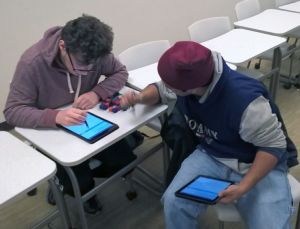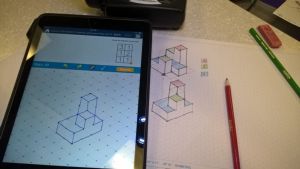

Researchers who have demonstrated that it is possible to improve students' spatial visualization skills, which are key for success in some STEM courses and careers, are testing their curriculum with community college students.
The first 95 students who completed the non-credit spatial skills course at Del Mar College, McHenry County College, and Tidewater Community College earned on average, one full letter grade higher (a grade of B) in the introductory STEM course they took than students who qualified for the spatial skills booster, but opted not to take it (and averaged a grade of C).
PDFs of the lesson plans and other content are available at http://www.higheredservices.org/spatial-course-mini-lectures/
Principal Investigator Susan Metz explained that this Advanced Techological Education project builds on spatial skills research, that has been funded with multiple National Science Foundation grants to address the spatial skills deficits of four-year university students.
The focus of the current ATE project grant (Adapting Tested Spatial Skills Curriculum to Online Format for Community College Instruction: A Critical Link to Retain Technology Students) is to identify the impact of spatial skills instruction on students in technician education programs. The research questions include the following: Do better spatial skills increase students' persistence in technical degree programs? Do online or hybrid course formats serve community college students more effectively given their challenging schedules?
The researchers have shown that although women and underrepresented minority students disproportionately find rotating 3-D images challenging, they can improve their spatial skills and overcome this hindrance to completing a STEM degree. "Spatial visualization is a malleable skill," Metz said during an interview at the 2016 ATE Principal Investigators Conference.
The ATE project's initial data on grade improvement among community college students are promising; preliminary retention data will not be available until mid-2017.
Metz, who is executive director of diversity and inclusion and a senior research associate at Stevens Institute of Technology, is also the principal investigator of Engaging Students in Engineering (ENGAGE). This NSF initiative partners with 70 engineering programs to increase student retention with the addition of Everyday Examples in Engineering, better Faculty-Student Interaction, and improvement in students' Spatial Visualization Skills.
Much of the content for the community college spatial visualization skills project is based on a course that Sheryl Sorby developed with NSF funding beginning in the 1990s at Michigan Technological University. Since 2009, Michigan Tech has required students who perform poorly on the Purdue Spatial Visualization Test: Rotation (PSVT:R) given during orientation to take the spatial skills visualization course. Michigan Tech students' persistence and graduation rates, particularly those of women and underrepresented minorities, have improved since 2009.
Community Colleges Test Different Formats
The pre-assessment test results alone are "eye opening," said Bob Mihelich, instructor and chair of Applied Technology at McHenry County College in Crystal Lake, Illinois. About two-thirds of the students entering McHenry's manufacturing, engineering technology, construction management, digital media, and gaming programs scored below 70% on the Purdue Spatial Visualization Test: Rotation (PSVT:R) exam that the project uses for pre- and post-assessments.
The McHenry students who choose to take the spatial skills course that Mihelich teaches as a workshop have told him they "love it." Students are expected to work through online modules on their own and attend in-person sessions, which Mihelich has offered one evening a week and on Saturdays.
However, the issue at all the community colleges in the project is that only 18% of the 539 students who scored below 70% on the screening test followed through to complete the course. (Altogether 981 students at four colleges took the screening test during the project's first two years.)
The potential for long-term academic improvement and the $150 stipend that completers receive during the project has simply not been enough of an incentive for many community college students whose jobs or family responsibilities make an extra trip to campus or extending their time on campus unfeasible.
At Del Mar College in Corpus Christi, Texas, the course was offered to engineering and geographic information systems students in five weekly, three-hour sessions. Students also had to complete 10 hours of online modules.
"That's too much for many of our students," Phillip Davis, professor of computer science at Del Mar.
In an email Davis wrote: "One of our key findings is that trying to apply the workshop from university to community college is a challenge. The long-term solution we've discovered is either a) incorporate into existing curriculum or b) offer a separate one-credit-hour course. Both of these are very challenging to accomplish in our programs, where we've cut to the bone to meet state-mandated [credit] limits."
Metz explained that research clearly illustrates the value and impact of integrating the spatial skills course into existing, required curricula.
In response to this finding, Kenny Grimes, an associate professor of engineering, math and industrial technologies at Tidewater Community College in Norfolk, Virginia, added the spatial skills content to the established credit course Orientation to Engineering and Technology in the fall of 2016.
Incorporating the spatial skills content in an existing course "dramatically increased the number of students benefiting from the spatial skills content and eliminated the considerable effort of recruiting students to a voluntary course," Metz noted, adding that analysis of other outcomes is ongoing.
Sketching App Facilitates Differentiated Instruction
Mihelich is particularly enthusiastic about the iPad sketching app that he and Del Mar faculty have been testing since 2015. His students at McHenry have responded well to the game-like structure that immediately tells them if they have made a mistake and uses game strategies to encourage them to revise their technical drawings.
The developer of the iPad sketching app, Nathan Delson, director of the Mechanical and Aerospace Engineering Design Center at the University of California San Diego, recently received an NSF Small Business Innovation Research grant to further develop the software that has been influenced by the results of the ATE project colleges.
"Its ability to give real-time feedback on how someone is performing is truly amazing," he said of the data that instructors receive on their app dashboards. Because the instructors' version of the app allows instructors to see what students do on each attempt, Mihelich uses this feature to offer more targeted one-on-one instruction. Being able to differentiate his teaching is particularly helpful midway through the semester when some students are sailing through the sketching exercises while others are struggling with the basic concepts.
"I think the spatial visualization workshop is just wonderful and something that I'm looking to formalize in our curriculum as we move forward," Mihelich said.

 Subscribe
Subscribe


 See More ATE Impacts
See More ATE Impacts

Comments
There are no comments yet for this entry. Please Log In to post one.